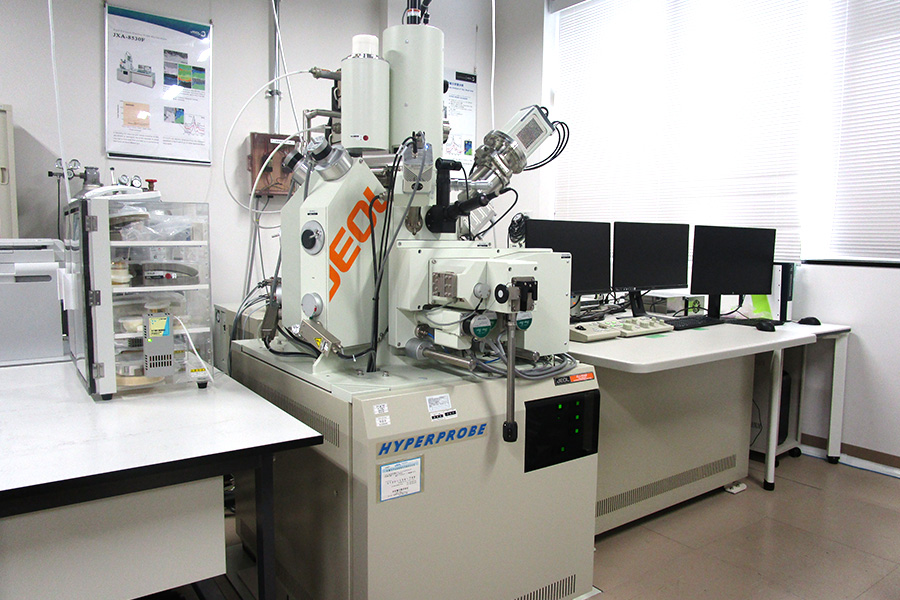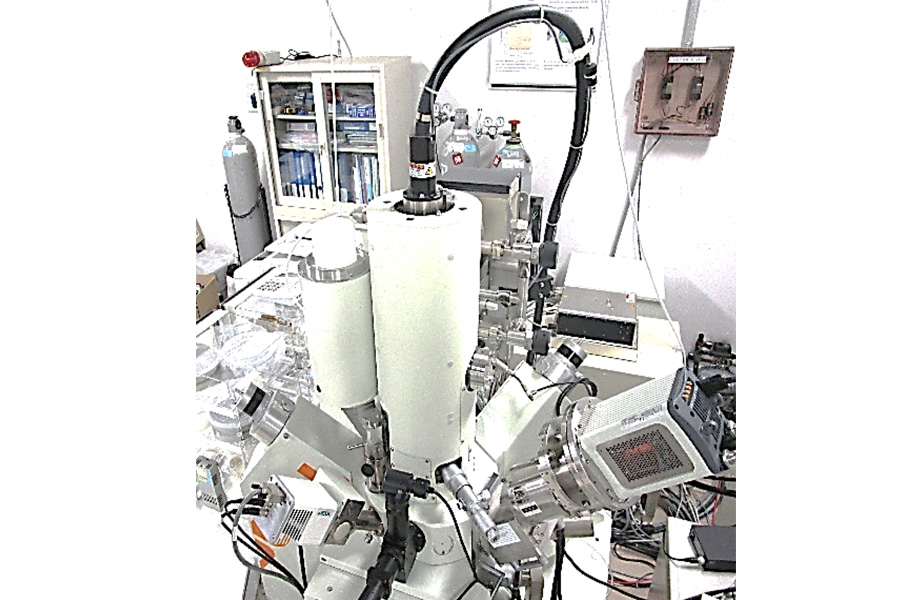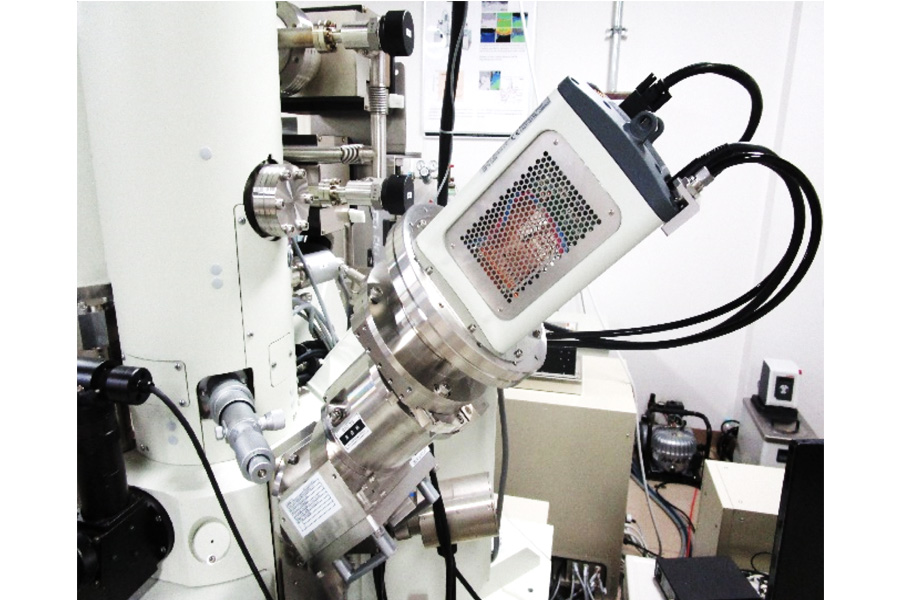Shared equipment
- Top
- Shared equipment
- Field Emission Electron Probe Microanalyzer with SXES
Shared equipment
Field Emission Electron Probe Microanalyzer with SXES
Field Emission Electron Probe Microanalyzer with SXES
JXA-8530F+SXES
Equipment Overview (Purpose)
This instrument is designed to measure the shape, type, content, and distribution state of the constituent elements of a sample from various angles. It utilizes wavelength dispersive spectroscopy (WDX), in which a converged electron beam is irradiated onto the surface of a solid sample. The characteristic X-rays, secondary electrons and reflected electrons generated are diffracted and detected by a spectroscopic crystal.
Main Features and Applications
【Features】
- The use of a Schottky-type FE electron gun enables clear, high-magnification images to be acquired. The WDS has high wavelength resolution, and the five monochromators are equipped with a variety of spectroscopic crystals, enabling measurement of elements from B to U.
- The WDS has a high wavelength resolution and is equipped with five spectrometers and a variety of crystal spectrometers to measure elements from B to U. The particle measurement program can measure the area, area fraction, Feret diameter, center of gravity, perimeter, and circularity of particles by performing various measurements of particle characteristics based on the collected surface analysis data.
【Applications】
- It is used in a wide range of fields, including industrial fields such as metals, new materials, catalysts, semiconductors, steel materials, slag, and concrete, as well as earth science research such as geology, minerals, and meteorites, because it enables elemental analysis and observation of extremely small to large areas of the surface without destroying the sample.
Main Specifications
| Analytical element range | WDS:(Be)B~U、 EDS:B~U |
|---|---|
| X-ray spectral range | WDS spectral range: 0.087~9.3nm EDS spectral range: 20keV |
| Number of X-ray spectrometers | 100mm×100mm×50mm(thickness) |
| Acceleration voltage | 1~30kV (0.1kV step) |
| Irradiation Current Range | 10-12~ 5×10-7A |
| Stability of irradiation current | ±0.3 %h |
|---|---|
| Secondary electron resolution | 3nm(W.D. 11mm、30kV) |
| Analysis Conditions Secondary electron resolution |
40nm(10kV, 1×10-8A) 100nm(10kV, 1×10-7A) |
| Scanning magnification | ×40~300,000(W.D.11mm) |
| Scanning resolution | Maximum of 5,120 x 3,840 |
Available Optional Features & Purpose of the Options
| Available Optional Features | Purpose of the Options |
|---|---|
| Available Optional Features:Optical Microscope Autofocus Sample Stage Controller | Purpose of the Options:Enables automatic alignment of the sample surface to the optical microscope focal position. |
| Available Optional Features:Sample Navigator | Purpose of the Options:Displays an image of the sample mounted on the holder on the monitor, and the stage can be controlled by clicking on the image. |
| Available Optional Features:Large Specimen Holder | Purpose of the Options:Capable of mounting specimens with maximum dimensions of 100 mm x 100 mm x 50 mm (thickness). |
| Available Optional Features:Tilting and Rotating Holder | Purpose of the Options:A specimen of 25.5 mm x 15 mm (maximum) thickness can be rotated 0 to 20 degrees to the right (secondary electron detector side) from the front of the optical tube in an inclined direction of 360 degrees (free-movement in the horizontal plane). |
| Available Optional Features:Phi-Rho-Z Method Quantitative Analysis Program | Purpose of the Options:Improvement of correction calculation accuracy is possible in the light elemental region. |
| Available Optional Features:Quantitative Map Program | Purpose of the Options:Quantitative correction calculations can be performed at each point from map data measured by a wavelength dispersive X-ray spectrometer (WDS) to create concentration maps and chemical composition maps. |
| Available Optional Features:Waveform Separation Program | Purpose of the Options:Waveform separation of weight peaks in WDS such as N-Kα and Ti-LI using a combination of digital filter method and least squares method. The separated results can be used as relative intensities in quantitative analysis programs as correction calculations. |
| Available Optional Features:Phase Analysis Program | Purpose of the Options:From plane analysis, line analysis, quantitative analysis, and qualitative analysis data, binary and ternary scatter plots, phase maps, etc. can be created to obtain correlations of constituent elements and analyze the connection of each correlation, and the number of displayable phases can be up to 63. |
| Available Optional Features:Arbitrary Curve Map Program | Purpose of the Options:Stage-scan surface analysis is possible even if the sample surface has complex unevenness or steps. Measurement results can be treated in the same way as data from normal surface analysis. |
| Available Optional Features:Carbon Deposition Equipment | Purpose of the Options:Sample Preparation |
| Available Optional Features:Soft X-ray Spectrometer SXES | Purpose of the Options:The soft X-ray spectrometer (optional) makes it possible to detect light elements such as Li, which were previously difficult to detect, and in combination with the WDS function of EPMA, enables one-stop compositional analysis. It is a powerful tool for state mapping of light elements. |
Interview
Field Emission Electron Probe Microanalyzer with SXES
JXA-8530F+SXES
Equipment Photo
Click on the photo to enlarge.
- Tohoku University
- Institute for Materials Research, Tohoku University
- Institute of Fluid Science, Tohoku University
- Institute of Multidisciplinary Research for Advanced Materials, Tohoku University
- Research Institute of Electrical Communication, Tohoku University
- Head Office of Enterprise Partnerships, Tohoku University
- Core Facility Center
- Bulk Soft Magnetic Materials, Tohoku University
- Advanced Imaging and Modeling Center for Soft-materials
(Tohoku AIMcS)
2013 © Material Solutions Center, Tohoku University. All rights.



